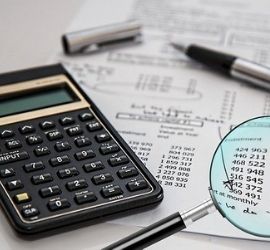What is an Account Summary Statement?
 An account summary is a periodic statement of account activity. It usually includes a beginning date and an ending date. The most common type is a checking account summary statement, usually provided monthly. Monthly credit card bills are also considered to be account statements. Additionally, brokerage account statements, which are provided monthly or quarterly.
An account summary is a periodic statement of account activity. It usually includes a beginning date and an ending date. The most common type is a checking account summary statement, usually provided monthly. Monthly credit card bills are also considered to be account statements. Additionally, brokerage account statements, which are provided monthly or quarterly.
In general, an account summary is a periodic statement summarizing account activity over a set period of time. Account statements can be thought of as a summary of the account’s recent activity. It will usually include a detailed breakdown of services provided, fees charged, and money owed. Account statements should be immediately scrutinized for accuracy. Historical statements are essential for budgeting.
Your Account Summary – A Closer Look
Account statements are generated for any type of account with ongoing transactions. For example, credit cardholders use their credit cards to make transactions at a point of sale, and the transactions are reflected as they occur. When the credit card holders pay the credit card debts, the funds are reflected in the account. At the end of the period, the credit company sends credit card bills that show all transactions conducted using the credit card, fees charged, and the current credit card balance that represents debts.
Online payment processors such as PayPal allow customers to access credit card statements for any specific period of interest. Any cash payments in and out of the account are shown in the statement, and the ending balance shows the current account balance at the end of the period. Service providers also send a periodic account statement to their customers, showing the level of consumption, unpaid credits, prepayments, and the amount due for the period. Examples of utility companies include cable TV service, telephone and internet subscription providers, water providers, and power companies.
The companies above generally bill their customers at the end of every month, and they send an account statement detailing all transactions in the customer’s account. The statement shows debits paid to the account, credits received, account maintenance fees, state taxes, and any surcharges included in the account. Some utility companies charge a fixed fee, which is incurred regardless of whether or not the customer consumes the service or product provided. (Source: corporatefinanceinstitute.com)
How To Use Your Account Summary
Account statements should be scrutinized for accuracy, and historical statements are critical for budgeting. A credit or loan account statement, for example, may show not only the outstanding balance due but the interest rate charged on that debt and any fees that have been added during the payment cycle. This can include late charges for payments not received by their due date as well as overdraft fees when bank account holders overspend. Your account statements are a window into your finances.
The statement may also list financial information that relates to the account holder. This may include their credit score, or the estimated time it will take to completely pay off debt via installment payments. Alerts and notices to the account holder may also appear on these statements, calling attention to matters with the account that need to be addressed, such as unusual charges that should be reviewed and verified. (Source: investopedia.com)
Components of an Account Summary Statement
An account statement should provide financial information that gives an accurate overview of the customer’s transaction history during the billing cycle. The upper section of the account statement shows the name, address, phone number, and email address of both the business and the customer. The other components include:
- Date range: The time interval covered by the statement. Generally, the statement can cover a specific month, quarter, or year.
- Opening balance: The starting amount in the account statement and shows the amounts due for the previous period.
- Invoiced amount: The total amount of goods or services that the customer consumed during the current period.
- Amount paid: The total amount that the customer has already paid and deducted from the amount invoiced in the current period.
- Balance due: The amount that the customer is required to pay to the company in the current period. It can be positive (customer owes the vendor money), negative (vendor owes the customer), or zero (all payments have been settled). (Source: corporatefinanceinstitute.com)
Available Balance vs. Actual Balance
For savings, checking and certificate accounts, the “Available Balance” is the amount currently available for withdrawal from the account. The “Actual Balance” is the total amount on deposit in the account. These amounts could be different under certain circumstances, such as:
- Temporary hold – If a temporary hold was placed on a check you recently deposited.
- Restrictions – For example, if withdrawals are not allowed from the account until a maturity date (such as for a certificate), or due to other restrictions.
- Secured collateral – If funds have been secured as collateral on a loan.
- Pending – If you have made a purchase with your debit card and funds are being held until the transaction is posted (remember that some merchants hold funds in an amount different from the actual purchase amount).
- Misc policies – Or for another reason according to your institution’s policies and account servicing procedures. Contact us if you have any questions about the availability of funds from your accounts.
Special note: If you have paid extra money into your credit card account in order to temporarily increase the credit limit, then the summary will show your Balance as if it were a negative amount, like this: ($500.00). When you click on the account description to see more details about the account then you’ll be able to see how this overpayment affects the funds that are available on your account. (Source: itsme247.com)
Regular Payment vs. Amount Due
For loan accounts, the “Regular Payment” is your normal scheduled payment amount. The “Amount Due” is the amount that is owed on or before the “Date Due” shown. This amount may be different from the regular payment if your payment is past due, or if you have already paid part of your next payment. (Source: ibid)
Red Flags on Your Account Summary
Reviewing your account statements as they come in is a good financial habit. Items you don’t recognize on an account summary statement may be a sign the account has been compromised. Perhaps through a stolen credit or debit card or through identity thieves who gained access to account information. For example, an account holder might spot a charge for concert tickets or a luxury item that they never purchased. Account-holders may be able to dispute such out-of-place charges and file a claim that they did not make the purchase themselves. Reviewing your account statements as they come in makes good financial sense. It can help catch these red flags before they become a financial disaster.
What are Identity Theft Red Flags?
Identity theft is when someone uses your personal data — name, Social Security number, birth date, etc. — to impersonate you. Most often, it’s for financial gain at your expense. They might use that information to drain your bank and investment accounts or open new credit lines in your name. Other scams are to get utility service, steal your tax refund, get access to medical treatments, or give police your name and address when they are arrested. Identity theft red flags are suspicious patterns, practices, and activities that indicate the possibility of identity theft. Look for these flags whenever you review your monthly account summary statements and reports.
Why the Account Summary is Important – Final Words
An account statement is sent to customers to provide:
- A summary of products and services consumed and billed for a given period. Any amount paid to the account during the period is shown on the statement. Also, any amount that remains unpaid for the billed period, and the billing cycles preceding the current cycle.
- Opportunity to dispute charges – The customer also uses the account statement to dispute any transaction that needs to be addressed by the service provider or financial institution. For example, the amount owed may include additional costs such as penalties for delayed payments, the interest charged on the debt owed, overdraft fees, double charges, etc. The additional costs increase the total amount owed, and the customer may require these costs to be reviewed to reduce the debt burden.
- A historical record – The account statement is also important when checking the consistency of information in a customer’s account. The business can use it to verify that a customer’s already paid all the amounts owed to the business, and if there are any missed payments, the business owner can send a payment reminder to the customer.
The account holder should review and verify all payments to ensure the accuracy of recorded transactions. It helps to identify if there are double charges or double payments captured in the system. Some recurring customers receive an invoice periodically. The account statement makes it easier to view all invoices sent to the customer and payments received from the customer. Discrepancies are more easily detected and rectified. (Source: Corporatefinanceinstitute.com)
Up Next: What Is a Bull Put Spread?
A bull put spread is an options trading strategy. Investors use it when they expect a moderate rise in the price of the underlying asset. The strategy employs two put options to form a range. One sets the high strike price and the other, a low strike price. The investor aims to receive a net credit from the difference between the two premiums from the options. The maximum loss is equal to the difference between the strike prices and the net credit received. The maximum profit occurs if the stock’s price closes above the higher strike price at expiry.



